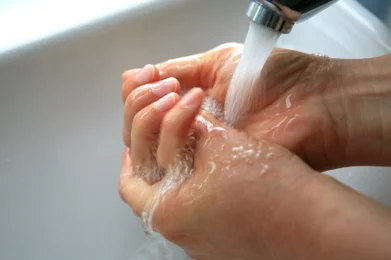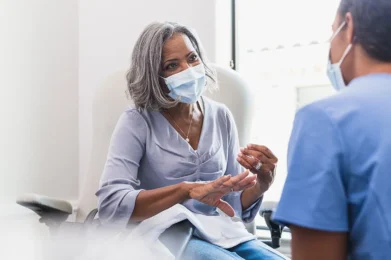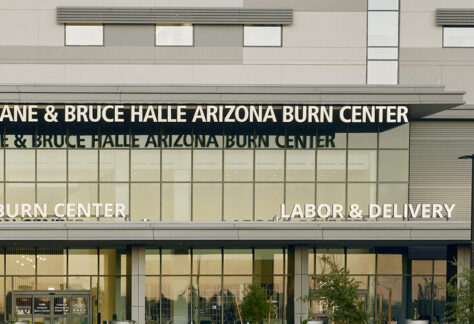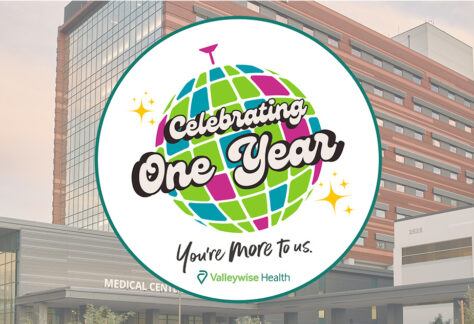In This Article:
- Dr. Frank LoVecchio prefers emergency care to specialty care because it allows him to pursue a wide range of medical interests rather than just one.
- The most common reasons for seeking emergency health care in Phoenix are chest pain, breathing problems, broken bones, cuts, burns, abdominal pain and high fevers.
- If you ever go to the ER, be sure to ask questions, know your medical history, ask for document copies and bring someone along with you, if possible.
At Valleywise Health, we’re proud to have compassionate, diverse teams of emergency health care workers who treat patients from all walks of life at a moment’s notice. Twenty-four hours a day, seven days a week and 365 days a year, our resilient employees are always ready to serve.
Today, we get an inside perspective from Dr. Frank LoVecchio, a Valleywise Health emergency medicine doctor who’s been practicing since 1992. He shares his most unforgettable stories and life lessons from the past three decades of his career. Let’s get started!
Why pursue emergency medicine?
Dr. LoVecchio discovered his passion for working in the ER during his rotations as a medical student. By immersing himself in various fields — from surgery to pediatrics — he was able to pursue all his interests, rather than limiting himself to just one. Since then, Dr. LoVecchio has obtained four specialty certifications and a public health degree.
“Knowing a little bit about everything is great in my position, because I see everyone from babies to seniors,” he said. “The emergency department always keeps me on my toes.”
What training does an emergency medicine doctor complete?
Generally speaking, an emergency medicine physician must complete the following training:
- Undergraduate school (typically four years)
- Medical school (typically four years)
- Residency program (typically three or four years)
After completing the residency, one can begin practicing as a full-blown physician.
How accurate are hospital TV shows?
Not very. The soap-opera-style drama portrayed in shows like Grey’s Anatomy can create unrealistic expectations for viewers. The true outcome of cardiac arrest, for example, isn’t nearly as favorable as how it’s shown on television — where patients often recover quickly as if nothing ever happened. In reality, less than 5 percent of people survive cardiac arrest. These frequent “miracles” on TV can set impossible standards for emergency health care workers.
“Some shows don’t help us in portraying what is physiologically possible,” Dr. LoVecchio said.
One aspect that is realistic, however, is the wide range of cases that ER doctors encounter. Every day is truly unpredictable, and you never know what type of patient you will see next.
What’s the biggest misconception of emergency health care?
Working in the ER isn’t “go, go, go” all the time. Sometimes the sickest patients are the easiest to care for. When someone is admitted with a heart attack or stroke, for example, there’s usually only about 20 minutes of intensity before the person embarks on a slow and steady recovery. Also, most of the patients in the emergency room do not have life-threatening conditions.
What’s the most difficult part of being an ER doctor?
According to Dr. LoVecchio, training simulations in the lab are nothing compared to dealing with real people. The most challenging part by far, he says, is breaking bad news to families. It’s hard to grasp that one small accident can drastically alter the course of a patient’s life with no warning.
“It breaks your heart,” he said. “Some of these stories still play out in my head 30 years later.”
How has COVID-19 changed the way emergency rooms function?
COVID-19 has forced emergency rooms to adapt and overcome against all odds. The big question was, “How can we protect people from the environment, while protecting the environment from people?”
Every part of the health care experience must now meet higher sanitation standards than ever before.
Dr. LoVecchio also noted how much he has learned to appreciate nurses. Nurses are hands-on employees who often work in the trenches of health care, especially during COVID-19. Doctors, on the other hand, are generally there to supervise and provide direction. Regardless of position, the resiliency shown by all emergency health care workers during this time will prevail long after the pandemic has passed.
What makes the Valleywise Health Emergency Department special?
Dr. LoVecchio believes the people make all the difference. If someone ever feels discouraged by the location of our emergency facilities, he reminds them that most ER doctors elsewhere in town graduated from the Valleywise Health Emergency Medicine program.
As Phoenix’s only teaching hospital for emergency medicine residents, we perform cutting-edge research and inspire the next generation of medical professionals. Over the last few years, we’ve received millions of dollars in funding for research and training. They choose to support Valleywise Health over other institutions because we have the science, compassion and drive to make a difference.
Why do most people seek emergency health care?
The most common reason for seeking emergency treatment depends on where you live. Within the Phoenix community, we frequently encounter the following ailments:
- Chest pain (e.g. heart attack, blood clot)
- Breathing problems (e.g. asthma, pneumonia)
- Broken bones
- Cuts and lacerations
- Severe burns
- Abdominal pain
- High fevers
What should you expect during an ER visit?
If you’re expecting to receive treatment as soon as you walk in — don’t. Sometimes, people need to go ahead of you based on priority. You may get grumpy when you see someone “cutting in line,” but this could quite literally be a matter of life or death. Doctors will rarely give you an estimated waiting time, but be prepared to wait three or more hours if your condition isn’t life-threatening.
Once you are brought back for treatment, you’ll encounter a whole medical team rather than just one doctor. Since Valleywise Health is a teaching hospital, we believe the more eyes we have on your case, the better your outcome will be. You will potentially interact with:
- A resident, who has been out of medical school for one to three years.
- A medical student, who is supervised by the resident.
- A tenured physician like Dr. LoVecchio, who supervises both younger team members.
What can I do to avoid going to the ER?
Believe it or not, you can take preventative measures every day to keep yourself out of the emergency room. Although nothing is 100% foolproof, these examples can reduce your chance of injury or death:
- Wear your seatbelt in the car.
- Wear your helmet on a bike or motorcycle.
- Use common sense and caution when climbing a ladder, jumping off a diving board, skiing, hiking or performing any other potentially dangerous activity.
- You knew this was coming, right? Get vaccinated against the flu and COVID-19.
- Help yourself and others by learning basic first aid and CPR practices.
How can I be a good ER patient?
If you do find yourself requiring emergency health care, there are a few things you do as a patient to make your experience more pleasant, including:
- Asking your doctor questions
- Knowing your medications
- Understanding your family and personal history
- Asking for copies of everything, from test results to billing documents.
- Bringing someone with you to guide you through tough decisions.
Now that you’ve gotten a glimpse of what it’s like to be a real ER doctor, it’s easier to empathize with the trauma they face every day. Should you ever need emergency treatment, experienced physicians like Dr. LoVecchio are waiting to care for you around the clock at the Valleywise Health Emergency Department.







